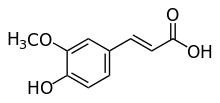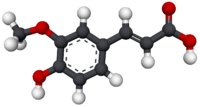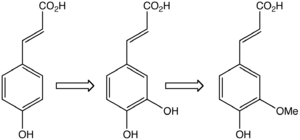Ferulic acid
 | |
 | |
| Names | |
|---|---|
| IUPAC name
(E)-3-(4-hydroxy-3-methoxy-phenyl)prop-2-enoic acid | |
| Other names
2-propenoic acid, 3-(4-hydroxy-3-methoxyphenyl)- ferulic acid 3-(4-hydroxy-3-methoxyphenyl)-2-propenoic acid 3-(4-hydroxy-3-methoxyphenyl)acrylic acid 3-methoxy-4-hydroxycinnamic acid 4-hydroxy-3-methoxycinnamic acid (2E)-3-(4-hydroxy-3-methoxyphenyl)-2-propenoic acid Ferulate Coniferic acid trans-ferulic acid (E)-ferulic acid | |
| Identifiers | |
| 3D model (JSmol) |
|
| ChEBI | |
| ChemSpider | |
| DrugBank | |
| ECHA InfoCard | 100.013.173 |
| PubChem CID |
|
| |
| |
| Properties | |
| C10H10O4 | |
| Molar mass | 194.18 g/mol |
| Appearance | Crystalline Powder |
| Melting point | 168 to 172 °C (334 to 342 °F; 441 to 445 K) |
| 0.78 g/L[1] | |
| Acidity (pKa) | 4.61[1] |
| Hazards | |
| NFPA 704 | |
| Except where otherwise noted, data are given for materials in their standard state (at 25 °C [77 °F], 100 kPa). | |
| | |
| Infobox references | |
Ferulic acid is a hydroxycinnamic acid, a type of organic compound. It is an abundant phenolic phytochemical found in plant cell wall components such as arabinoxylans as covalent side chains. It is related to trans-cinnamic acid. As a component of lignin, ferulic acid is a precursor in the manufacture of other aromatic compounds. The etymology is from the genus Ferula, referring to the giant fennel (Ferula communis).
Occurrence in nature
As a building block of lignocelluloses, such as pectin[2] and lignin, ferulic acid is ubiquitous in the plant kingdom.
In food
Ferulic acid is found in the seeds of coffee, apple, artichoke, peanut, and orange, as well as in both seeds and cell walls of commelinid plants (such as rice, wheat, oats, the Chinese water chestnut (Eleocharis dulcis) and pineapple). Often in the form of chlorogenic acid.
In cereals, ferulic acid is localized in the bran the hard outer layer of grain. In wheat, phenolic compounds are mainly found in the form of insoluble bound ferulic acid and be relevant to resistance to wheat fungal diseases.[3] The highest known concentration of ferulic acid glucoside has been found in flaxseed (4.1 ± 0.2 g/kg).[4] It is also found in barley grain.[5]
Asterid eudicot plants can also produce ferulic acid. The tea brewed from the leaves of yacón (Smallanthus sonchifolius), a plant traditionally grown in the northern and central Andes, contains quantities of ferulic acid. In legumes, the white bean variety navy bean is the richest source of ferulic acid among the common bean (Phaseolus vulgaris) varieties.[6] It is also found in horse grams (Macrotyloma uniflorum).[7]
Although there are many sources of ferulic acid in nature, its bioavailability is limited based on the form in which it is present, with free ferulic acid having a poor water solubility hence poor bioavailability. In wheat grain, ferulic acid is found bound to cell wall polysaccharides, which has an effect on its release and absorption in the small intestine.[8]
In herbal medicines
Ferulic acid has been identified in Chinese medicine herbs such as Angelica sinensis (female ginseng), Cimicifuga heracleifolia[9] and Ligusticum chuangxiong. It is also found in the tea brewed from the European centaury (Centaurium erythraea), a plant used as a medical herb in many parts of Europe,[10]
In processed foods
Cooked sweetcorn releases increased levels of ferulic acid.[11] As plant sterol esters, this compound is naturally found in rice bran oil, a popular cooking oil in several Asian countries.[12]
Ferulic acid glucoside can be found in commercial breads containing flaxseed.[13] Rye bread contains ferulic acid dehydrodimers.[14]
Metabolism

Biosynthesis
Biosynthesis of ferulic acid is by the action of the enzyme caffeate O-methyltransferase.[15] It is biosynthesized from caffeic acid.
Ferulic acid, together with dihydroferulic acid, is a component of lignocellulose, serving to crosslink the lignin and polysaccharides, thereby conferring rigidity to the cell walls.[16]
It is an intermediate in the synthesis of monolignols, i.e., the monomers of lignin, and is also used for the synthesis of lignans.
Biodegradation
Ferulic acid is converted by certain strains of yeast, notably strains used in brewing of wheat beers, such as Saccharomyces delbrueckii (Torulaspora delbrueckii), to 4-vinyl guaiacol (2-methoxy-4-vinylphenol) which gives beers such as Weissbier and Wit their distinctive "clove" flavour. Saccharomyces cerevisiae (dry baker's yeast) and Pseudomonas fluorescens are also able to convert trans-ferulic acid into 2-methoxy-4-vinylphenol.[17] In P. fluorescens, a ferulic acid decarboxylase has been isolated.[18]
Ecology
Ferulic acid is one of the possible plant compounds that initiate Agrobacterium tumefaciens to infect plant cells.
Extraction
It can be extracted from wheat bran and maize bran using concentrated alkali.[19]
Bio-medical considerations
Ferulic acid, like many natural phenols, is an antioxidant in vitro in the sense that it is reactive toward free radicals such as reactive oxygen species (ROS). ROS and free radicals are implicated in DNA damage, cancer, and accelerated cell aging. Animal studies and in vitro studies suggest that ferulic acid may have direct antitumor activity against breast cancer[20] and liver cancer.[21] Ferulic acid may have pro-apoptotic effects in cancer cells, thereby leading to their destruction.[21] Ferulic acid may be effective at preventing cancer induced by exposure to the carcinogenic compounds benzopyrene[22] and 4-nitroquinoline 1-oxide.[23] Note that these are not randomized controlled trials done with human participants, and therefore, the results of these studies may not be directly applicable to human use.
If added to a topical preparation of ascorbic acid and vitamin E, ferulic acid may reduce oxidative stress and formation of thymine dimers in skin.[24] There is also a small amount of research showing oral supplements of ferulic acid can inhibit melanin production in the process of skin whitening.[25]
Other applications
As a precursor to vanillin
Ferulic acid, being highly abundant, may be useful as a precursor in the manufacturing of vanillin, a synthetic flavoring agent often used in place of natural vanilla extract.[26] However, biotechnological processes may be the most efficient method to use ferulic acid as a precursor,[27] and as such, research is still ongoing.
Mass spectrometry
It is used as a matrix for proteins in MALDI mass spectrometry analyses.[28]
Bitterness masker
Kraft Foods has patented the use of sodium ferulate to mask the bitter aftertaste of the artificial sweetener acesulfame potassium.[29]
See also
- Caffeic acid
- Coumaric acid
- Diferulic acids
- Eugenol
- Isoferulic acid, an isomer of ferulic acid
References
- 1 2 Mota, Fátima L.; Queimada, António J.; Pinho, Simão P.; Macedo, Eugénia A. (August 2008). "Aqueous Solubility of Some Natural Phenolic Compounds". Industrial & Engineering Chemistry Research. 47 (15): 5182–5189. doi:10.1021/ie071452o.
- ↑ Saulnier, Luc; Thibault, Jean-François (1 March 1999). "Ferulic acid and diferulic acids as components of sugar-beet pectins and maize bran heteroxylans". Journal of the Science of Food and Agriculture. 79 (3): 396–402. doi:10.1002/(SICI)1097-0010(19990301)79:3<396::AID-JSFA262>3.0.CO;2-B.
- ↑ Gelinas, Pierre; McKinnon, Carole M. (2006). "Effect of wheat variety, farming site, and bread-baking on total phenolics". International Journal of Food Science and Technology. 41 (3): 329–332. doi:10.1111/j.1365-2621.2005.01057.x.
- ↑ Beejmohun, Vickram; Fliniaux, Ophélie (2007). "Microwave-assisted extraction of the main phenolic compounds in flaxseed". Phytochemical Analysis. 18 (4): 275–285. doi:10.1002/pca.973.
- ↑ Quinde-Axtell, Zory; Baik, Byung-Kee (2006). "Phenolic Compounds of Barley Grain and Their Implication in Food Product Discoloration". J. Agric. Food Chem. 54 (26): 9978–9984. doi:10.1021/jf060974w.
- ↑ Luthria, Devanand L.; Pastor-Corrales, Marcial A. (2006). "Phenolic acids content of fifteen dry edible bean (Phaseolus vulgaris L.) varieties". Journal of Food Composition and Analysis. 19: 205–211. doi:10.1016/j.jfca.2005.09.003.
- ↑ Kawsar, S. M. A.; Huq, E.; Nahar, N.; Ozeki, Y. (2008). "Identification and Quantification of Phenolic Acids in Macrotyloma uniflorum by Reversed Phase-HPLC". American Journal of Plant Physiology. 3 (4): 165–172. doi:10.3923/ajpp.2008.165.172.
- ↑ Anson, Nuria Mateo; van den Berg, Robin; Bast, Aalt; Haenen, Guido R. M. M. (2009). "Bioavailability of ferulic acid is determined by its bioaccessibility". Journal of Cereal Science. 49 (2): 296–300. doi:10.1016/j.jcs.2008.12.001.
- ↑ Sakai, S.; Kawamata, H.; Kogure, T.; Mantani, N.; Terasawa, K.; Umatake, M.; Ochiai, H. (1999). "Inhibitory effect of ferulic acid and isoferulic acid on the production of macrophage inflammatory protein-2 in response to respiratory syncytial virus infection in RAW264.7 cells.". Mediators of Inflammation. 8 (3): 173–175. PMC 1781798
 . PMID 10704056. doi:10.1080/09629359990513.
. PMID 10704056. doi:10.1080/09629359990513. - ↑ Valentão, P.; Fernandes, E.; Carvalho, F.; Andrade, P. B.; Seabra, R. M.; Bastos, M. L. (2001). "Antioxidant Activity ofCentaurium erythraeaInfusion Evidenced by Its Superoxide Radical Scavenging and Xanthine Oxidase Inhibitory Activity". Journal of Agricultural and Food Chemistry. 49 (7): 3476–3479. PMID 11453794. doi:10.1021/jf001145s.
- ↑ "Cooking sweet corn boosts its ability to fight cancer and heart disease by freeing healthful compounds, Cornell scientists find". Cornell News. Retrieved 2009-09-07.
- ↑ Orthoefer, F. T. (2005). "Chapter 10: Rice Bran Oil". In Shahidi, F. Bailey's Industrial Oil and Fat Products. 2 (6th ed.). John Wiley & Sons, Inc. p. 465. ISBN 978-0-471-38552-3. Retrieved 2012-03-01.
- ↑ Strandås, C.; Kamal-Eldin, A.; Andersson, R.; Åman, P. (2008). "Phenolic glucosides in bread containing flaxseed". Food Chemistry. 110 (4): 997–999. doi:10.1016/j.foodchem.2008.02.088.
- ↑ Boskov Hansen, H.; Andreasen, M.; Nielsen, M.; Larsen, L.; Knudsen, Bach K.; Meyer, A.; Christensen, L.; Hansen, Å. (2014). "Changes in dietary fibre, phenolic acids and activity of endogenous enzymes during rye bread-making". European Food Research and Technology. 214 (1): 33–42. ISSN 1438-2377. doi:10.1007/s00217-001-0417-6.
- ↑ Shahadi, Fereidoon; Naczk, Marian (2004). Phenolics in Food and Nutraceuticals. Florida: CRC Press. p. 4. ISBN 1-58716-138-9.
- ↑ Iiyama, K.; Lam, T. B.-T.; Stone, B. A. (1994). "Covalent Cross-Links in the Cell Wall". Plant Physiology. 104 (2): 315–320. ISSN 0032-0889. doi:10.1104/pp.104.2.315.
- ↑ Huang, Z.; Dostal, L.; Rosazza, J. P. (1993). "Microbial transformations of ferulic acid by Saccharomyces cerevisiae and Pseudomonas fluorescens". Applied and Environmental Microbiology. 59 (7): 2244–2250. PMC 182264
 . PMID 8395165.
. PMID 8395165. - ↑ Huang, Z.; Dostal, L.; Rosazza, J. P. (1994). "Purification and characterization of a ferulic acid decarboxylase from Pseudomonas fluorescens". Journal of Bacteriology. 176 (19): 5912–5918. PMC 196807
 . PMID 7928951. doi:10.1128/jb.176.19.5912-5918.1994.
. PMID 7928951. doi:10.1128/jb.176.19.5912-5918.1994. - ↑ Buranov, Anvar U.; Mazza, G. (2009). "Extraction and purification of ferulic acid from flax shives, wheat and corn bran by alkaline hydrolysis and pressurised solvents". Food Chemistry. 115 (4): 1542–1548. doi:10.1016/j.foodchem.2009.01.059.
- ↑ Kampa, M.; Alexaki, V. I.; Notas, G.; Nifli, A. P.; Nistikaki, A.; Hatzoglou, A.; Bakogeorgou, E.; Kouimtzoglou, E.; Blekas, G.; Boskou, D.; Gravanis, A.; Castanas, E. (2004). "Antiproliferative and apoptotic effects of selective phenolic acids on T47D human breast cancer cells: Potential mechanisms of action". Breast Cancer Research. 6 (2): R63–R74. PMC 400651
 . PMID 14979919. doi:10.1186/bcr752.
. PMID 14979919. doi:10.1186/bcr752. - 1 2 Lee, Y. S. (2005). "Role of NADPH oxidase-mediated generation of reactive oxygen species in the mechanism of apoptosis induced by phenolic acids in HepG2 human hepatoma cells". Archives of pharmacal research. 28 (10): 1183–1189. PMID 16276977. doi:10.1007/bf02972984.
- ↑ Lesca, P. (1983). "Protective effects of ellagic acid and other plant phenols on benzoapyrene-induced neoplasia in mice". Carcinogenesis. 4 (12): 1651–1653. PMID 6317220. doi:10.1093/carcin/4.12.1651.
- ↑ Mori, H.; Kawabata, K.; Yoshimi, N.; Tanaka, T.; Murakami, T.; Okada, T.; Murai, H. (1999). "Chemopreventive effects of ferulic acid on oral and rice germ on large bowel carcinogenesis". Anticancer Research. 19 (5A): 3775–3778. PMID 10625957.
- ↑ Lin, F. H.; Lin, J. Y.; Gupta, R. D.; Tournas, J. A.; Burch, J. A.; Selim, M. A.; Monteiro-Riviere, N. A.; Grichnik, J. M.; Zielinski, J.; Pinnell, S. R. (2005). "Ferulic Acid Stabilizes a Solution of Vitamins C and E and Doubles its Photoprotection of Skin". Journal of Investigative Dermatology. 125 (4): 826–832. PMID 16185284. doi:10.1111/j.0022-202X.2005.23768.x.
- ↑ Experimental Dermatology, August 2005, pages 601-608; Bioscience, Biotechnology, and Biochemistry, December 2005, pages 2368-2373; International Journal of Dermatology, August 2004, pages 604-607; Journal of Drugs in Dermatology, July–August 2004, pages 377-381; Facial and Plastic Surgery, February 2004, pages 3-9; Dermatologic Surgery, March 2004, pages 385-388; Journal of Bioscience and Bioengineering, March 2005, pages 272-276; Journal of Biological Chemistry, November 7, 2003, pages 44320-44325; Journal of Agriculture and Food Chemistry, February 2003, pages 1201-1207; International Journal of Cosmetic Science, August 2000, pages 291-303; and Anti-Cancer Research, September–October 1999, pages 3769-3774.
- ↑ Mathew, S.; Abraham, T. E. (2004). "Ferulic Acid: An Antioxidant Found Naturally in Plant Cell Walls and Feruloyl Esterases Involved in its Release and Their Applications". Critical Reviews in Biotechnology. 24 (2–3): 59–83. PMID 15493526. doi:10.1080/07388550490491467.
- ↑ Priefert, H.; Rabenhorst, J.; Steinbüchel, A. (2001). "Biotechnological production of vanillin". Applied microbiology and biotechnology. 56 (3–4): 296–314. PMID 11548997. doi:10.1007/s002530100687.
- ↑ Beavis, R. C.; Chait, B. T.; Fales, H. M. (1989). "Cinnamic acid derivatives as matrices for ultraviolet laser desorption mass spectrometry of proteins". Rapid Communications in Mass Spectrometry. 3 (12): 432–435. PMID 2520223. doi:10.1002/rcm.1290031207.
- ↑ US 5336513
